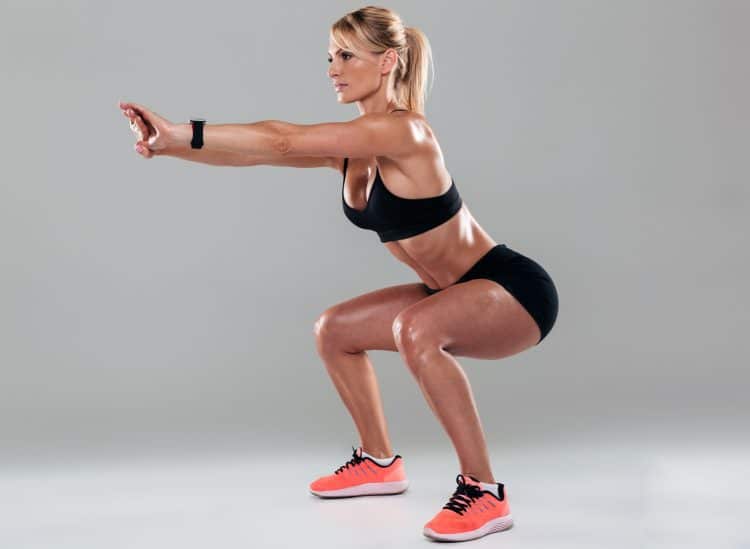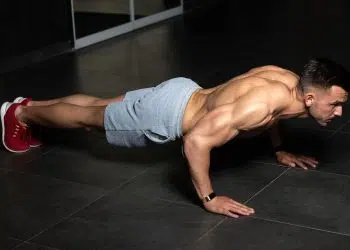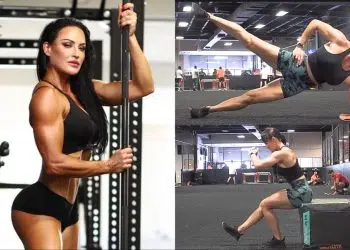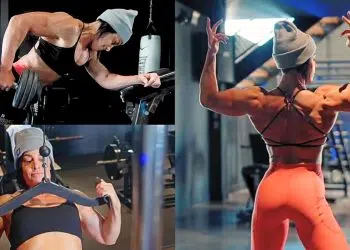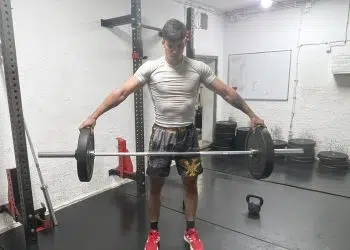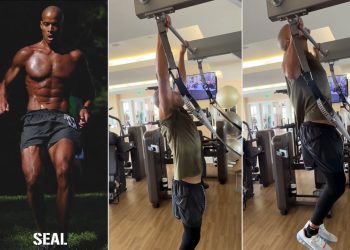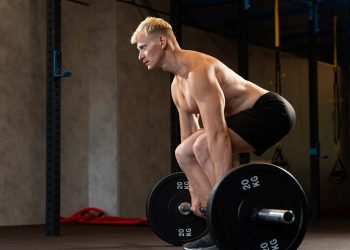The glutes are the largest and strongest muscle in the body. As a result, a lot of the power comes, quite literally, from your butt. Your hamstrings are also a powerful muscle group, enabling forward propulsion.
However, most people never realize the full potential of the glutes and hamstrings. Based on my 35-year experience as a personal trainer, I’d rate the glutes as the most under-trained muscle group among men, with the hamstrings not far behind.
The importance of a specific glute and hamstring workout cannot be overstated. Whether you’re a powerlifter, a bodybuilder, an athlete, or a person who wants a more functional, attractive body, you need to be working your glutes and hammies.
This article is a comprehensive, actionable glute and hamstring workout guide. Here’s what we’ll cover:
- Bodyweight Glute and Hamstring Workout
- Advanced Bodyweight Glute and Hamstring Workout
- Resistance Band Glute and Hamstring Workout
- Weighted Glute and Hamstring Workout
- Plyometrics Glute and Hamstring Workout
- Glute and Hamstring Anatomy
- Why Strong Glutes and Hamstrings Matter
- Case Study
- Preventing Glute and Hamstring Injury
- FAQs
5 Best Glute and Hamstring Workouts
Use the following workouts to elevate your posterior chain game:
1. Bodyweight Glute and Hamstring Workout
While you will need additional resistance to develop your glutes and hamstrings progressively, you can still get an effective basic workout with bodyweight exercises.
Level Up Your Fitness: Join our 💪 strong community in Fitness Volt Newsletter. Get daily inspiration, expert-backed workouts, nutrition tips, the latest in strength sports, and the support you need to reach your goals. Subscribe for free!
Here is a 12-week beginner-friendly bodyweight workout for building bigger and stronger glutes and hamstrings.
| Exercise | Sets | Repetitions |
| Squat | 3 | 15 |
| Reverse Lunge | 3 | 12 (each leg) |
| Glute Bridge | 3 | 12 |
| Donkey Kickback | 3 | 12 (each leg) |
Squats
Squats mainly work the gluteus maximus. This muscle contracts as you go into the squat to provide the propulsion for the upward push. The hamstrings help stabilize the knees and hips so they don’t collapse forward during the movement.
Step-by-Step Guide:
- Stand with feet shoulder-width apart and pointed slightly outward.
- Engage your core and keep your back straight.
- Lower your body by bending your knees and hips.
- Go as low as your flexibility allows without rounding your back.
- Push through your heels to return to the starting position.
Reverse Lunge
Lunges are excellent compound movements that target the glutes and hamstrings. The forward lunge emphasizes the glutes, while the reverse lunge shifts the focus to the hamstrings. So, our focus with this exercise is on the hamstrings.
Step-by-Step Guide:
- Stand with your feet together.
- Step one foot back and lower your body into a lunge.
- Keep your front knee aligned with your ankle.
- Push back to the starting position.
- Alternate between sides for recommended reps.
Glute Bridge
Glute bridges do a great job isolating and strengthening the glutes. They also boost hip stability and promote better posture.
Step-by-Step Guide:
- Lie on your back with your knees bent and feet flat on the floor.
- Place your hands, palms down, on the floor alongside you.
- Lift your hips as high as possible by squeezing your glutes.
- Hold for a few seconds.
- Lower your hips back down.
Donkey Kickbacks
Donkey kickbacks target the glutes with a dynamic, explosive movement. This is an excellent exercise to prepare your body for weighted kickbacks.
Step-by-Step Guide:
- Start on your hands and knees, with your wrists under your shoulders and knees under your hips.
- Keep your core engaged and maintain a neutral spine.
- Bend your right knee at a 90-degree angle, flexing your foot.
- Kick your right leg toward the ceiling, engaging your glutes and hamstrings.
- Squeeze your glutes at the top of the movement.
- Lower your knee back, but don’t touch it to the ground.
- Repeat for the desired reps.
- Switch to the left leg and repeat.
2. Advanced Bodyweight Glute and Hamstring Workout
The following exercises are significantly harder than those in the bodyweight workout above. Try adding them after a couple of months, doing three sets of 12 reps on each movement.
| Exercise | Sets | Repetitions |
| Nordic Curl | 3 | 12 |
| Heel Slides | 3 | 12 |
Nordic Curl
This exercise is similar to the glute-ham machine curl in the gym, except that you don’t need a machine to do it. All you need is an elevated surface to secure your ankles under. It could be a barbell, a strap, or someone pushing down on your ankles.
Step-by-Step Guide:
- Kneel on the floor with your ankles anchored under an elevated surface. Cross your hands in front of your chest.
- Slowly lower until your torso is as low to the ground as possible while maintaining a straight line from the head to the knees.
- Pull back to the start position by engaging your hamstrings.
Heel Slides
For this bodyweight exercise, you will need a pair of heel sliders (cloth mini-towels will work nicely). Do the exercise on a slick floor, allowing the sliders to move up and down effortlessly.
Step-by-Step Guide:
- Lie supine on a slick floor with a pair of heel sliders under your heels. Bend your knees just slightly so that your legs are nearly straight.
- Pull your right heel back toward your butt.
- Reverse the action to slide your right heel back to the start position.
- Repeat with the left heel.
3. Resistance Band Glute and Hamstring Workout
By introducing resistance bands to your workout, you can progressively increase the challenge to your glutes and hamstrings. This is the key to making these muscles bigger and stronger.
Here are four effective resistance band exercises for the glutes and hamstrings.
| Exercise | Sets | Repetitions |
| Banded Squat | 3 | 15 |
| Banded Leg Curl | 3 | 12 (each leg) |
| Banded Lateral Walk | 3 | 10 steps forward and back |
| Band Kickback | 3 | 12 (each leg) |
Banded Squat
Step-by-Step Guide:
- Place a loop resistance band under your feet and stand with your feet shoulder-width apart.
- Hold the band at shoulder level, with your palms facing forward.
- Push your hips back and bend your knees to perform a squat while maintaining tension on the band.
- Keep your knees in line with your toes.
- Push through your midfoot to return to the starting position.
Banded Leg Curl
Step-by-Step Guide:
- Anchor a resistance band to a sturdy object such as a doorway.
- Lie face down on the floor about two feet in front of the anchor point, facing away from it. Hook the band over your ankles.
- From a start position with your legs extended, bend your knees to bring your heels toward your butt. Squeeze your glutes and hamstrings as your legs come up.
- Lower your legs back down under control.
Banded Lateral Walk
Step-by-Step Guide
- Begin by securing a resistance band around your thighs. If you opt for ankle placement, select a lighter resistance band.
- Stand with your feet hip-width apart and slightly lean forward while keeping your ribcage and pelvis aligned.
- Engage your core muscles gently and initiate the movement by stepping to the right with your right leg. Strive to make each step as wide as possible without allowing your left leg to collapse inward.
- After stepping to the right, bring your right foot back to the starting position, maintaining a stance that is roughly hip-width apart.
- Continue this stepping motion for your desired number of repetitions, ensuring you perform an equal number of reps on the opposite side for balance.
Band Kickback
Step-by-Step Guide:
- Stand upright and place a loop band around your ankles, with your feet hip-width apart.
- Maintain a slight forward lean and engage your core muscles firmly, while also keeping a slight bend in the knee of your working leg.
- Shift your body weight onto one leg and lift the other off the ground. While ensuring that your leg remains straight, activate your glute to move the leg outward, creating an angle of approximately 45 degrees from your body.
- Return to the start position under control.
4. Weighted Glute and Hamstring Workout
In this section, I lay out the four best weighted exercises to hit the glutes and hamstrings. You will probably have to join a gym to do these exercises (unless you’ve got a super cool home gym set up!).
| Exercise | Sets | Repetitions |
| Multi-Hip Machine Glute Extension | 4 | 15 /10 /8/6 |
| Romanian Deadlift | 3 | 12/10/8 |
| Seated Leg Curl | 4 | 15 /10 /8/6 |
| Glute-Ham Raise | 3 | 12 |
Multi-Hip Machine Glute Extension
The glute extension on the multi-hip machine is the single best exercise for the glutes. The range of motion on the multi-hip machine glute extension is far superior to any other glute exercise. In addition, the exercise’s resistance curve is ideal as it allows for early phase loading, where the hardest part of the exercise is at the beginning of the movement.
Step-by-Step Guide:
- Stand alongside the multi-hip machine and place your closest knee over a roller set at hip height.
- Push down to move your glutes through their full range of motion.
- Return to the start position under control and repeat, ensuring a full range of motion.
- Do the same number of reps on both sides.
Romanian Deadlift
The Romanian Deadlift is a deadlift variation where you do not take the weight down to the floor between reps. This places greater emphasis on the hamstrings. It can be done with a barbell, dumbbells, or kettlebells.
Step-by-Step Guide:
- Stand with your feet shoulder-width apart and the weights in your hands at full arm extension. Maintain a neutral spine.
- Hinge the hips to lower the weight to the shin level. Allow your torso to come down to about a 45-degree angle.
- Push the hips forward to return to the start position.
Seated Leg Curls
Seated leg curls are a very effective isolation exercise for the hamstrings.
Step-by-Step Guide:
- Sit on a seated leg curl machine and adjust the pads for your height. You want the lower leg pad to be at shin level.
- Place your legs over the lower leg pad. In this start position, the legs should be almost straight.
- Push down to flex the hamstrings.
- Stop just short of full knee flexion.
- Return to the start position under control.
Glute-Ham Raise
The GHD raise is a very effective exercise for isolating the hamstring and glute muscles. This bodyweight exercise makes for a great finishing exercise after your resistance moves.
Step-by-Step Guide:
- Position yourself on a glute-ham raise machine so your ankles are under the rear support pads and your torso hangs over the hip pad.
- Lie flat so your body forms a straight line from head to toe. Cross your arms in front of your chest.
- Bend at the knees to pull your torso up to a kneeling position.
- Lower under control and repeat.
5. Plyometric Glute and Hamstring Workout
Plyometrics involves explosive jumping movements that mainly engage fast-twitch muscle fibers. They are great for developing glute and hamstring power because they rely on those muscles for propulsion, deceleration, and stabilization.
| Exercise | Sets | Repetitions |
| Box Jumps | 2 | 12 |
| Broad Jumps | 2 | 12 |
| Skater Jumps | 2 | 12 |
I recommend doing a 10-minute plyo session after your main glute and hamstring workout.
Box Jumps
Step-by-Step Guide:
- Start with a low-height box (12 inches). Stand with your feet positioned shoulder-width apart.
- Create tension by hinging at the hips, slightly squatting, and swinging your arms backward.
- Propel yourself upward, using both feet to lift simultaneously.
- Land with both feet shoulder-width apart. Transition into a mid-squat position and follow through with arm movement.
- Step down and repeat.
Broad Jumps
Step-by-Step Guide:
- Start with your feet shoulder-width apart.
- Generate tension by hinging at the hips, performing a slight squat, and swinging your arms back.
- Leap forward with both feet lifting off simultaneously.
- As you land, maintain shoulder-width foot placement, transitioning into a mid squat, and finish with arm follow-through.
Skater Jumps
Step-by-Step Guide:
- Position your feet shoulder-width apart.
- Shift your weight to your right leg, raising your left foot off the ground while slightly lowering your hips.
- Propel yourself laterally to the left by pushing off your right foot.
- Swiftly reverse the motion to jump back to the right.
- Continue this alternating movement pattern for the recommended time.
Glute and Hamstring Anatomy
Creating an effective glute and hamstring workout starts with understanding how these muscles work. This allows us to choose the best exercises to simulate each muscle optimally.
Glute Anatomy
Your glutes comprise three muscles:
- Gluteus maximus
- Gluteus medius
- Gluteus minimus
As the name indicates, the gluteus maximus is the largest of the three. The gluteus maximus muscle fibers originate on the inside edge of the posterior side of the pelvis just below the spine. They then travel diagonally to attach to the femur (upper leg bone).
The job of the gluteus maximus is to extend the hip joint by pulling the upper leg down and back. It also moves the body up from a seated or squatting position. This involves increasing the angle of the hip joint. That joint is the pivot between the upper legs and the torso. Moving either of those body parts will include the hip extension.
Hamstring Anatomy
The hamstrings are a group of four muscles on the back of the upper leg. The scientific names of these muscles are:
- Biceps femoris short head
- Biceps femoris long head
- Semimembranosus
- Semitendinosus
The biceps femoris long head originates on the pelvis, while the short head originates on the femur bone. They both insert at the head of the fibula, which is one of the two lower leg bones. The other two muscles originate on the pelvis and insert on the tibia, which is the larger of the two lower leg bones.
All four of the hamstring muscles work together to cause knee flexion. This brings the heel of the foot back and up toward the butt. The hamstrings also play a minor role in hip flexion and extension.
To work the hamstrings, you must simulate its natural biomechanical movement — bending the knee. Yet, the positioning of the hips is also important. Because the hamstrings cross over the hip joint, their position affects the length of the hammies.
Level Up Your Fitness: Join our 💪 strong community in Fitness Volt Newsletter. Get daily inspiration, expert-backed workouts, nutrition tips, the latest in strength sports, and the support you need to reach your goals. Subscribe for free!
When the hip angle is straight (such as when you are lying down), the hammies start the action from an overly shortened position. That is not ideal. The best position to work the hamstrings is seated, such as when doing a seated leg curl.
Why Strong Glutes and Hamstrings Matter
Here are the benefits of strong lower posterior chain muscles:
Sports Performance
Strong glutes are needed to do well in nearly every sport. They are involved in acceleration, deceleration, changing directions, and explosive jumping. They also help stabilize your body when performing on the court or field.
The hamstrings transfer stress from your knees to your hips during explosive movements, such as when a sprinter launches off the blocks. They also help control deceleration, helping to keep you safe when sprinting downhill.
Injury Prevention
Strong glutes reduce the risk of injury to the knees, lower back, hamstrings, and groin. Weak glutes can cause hip imbalance, which may result in excessive medial rotation of the femur and lateral tracking of the patella.
Compound Exercise Support
Strong glutes help offset lower back stress during compound exercises like deadlifts and squats. Inadequate strength in the glutes can also contribute to strained muscles in the groin or hamstrings.
Improved Posture
Gluteal strength is directly correlated to improvements in posture and balance and a reduction in lower back and knee pain. Your risk of injury due to muscle loss rises with age, so having strong glutes is necessary to preserve your athletic performance and overall health and well-being.
Your hips will also be more stable, and your spine will remain in the correct posture if you have strong hamstrings. Weak or tight hamstrings can lead to swayback posture and discomfort.
Case Study
To underscore how effective dedicated glute and hamstring workouts can be, I’d like to share the experience of one of my personal training clients. John, a 32-year bodybuilder/powerlifter, had hit a squat one-rep max (1RM) plateau.
John had been doing the typical bodybuilding split routine but wasn’t doing targeted glute work. I suggested that he add just a single 20-minute glute workout every week.
After three months, John’s squat went from 275 to 345 pounds. Better yet, his squat form improved, and the niggling lower back pain he’d grown used to disappeared.
John’s experience exemplifies how strengthening the glutes can dramatically improve your overall performance in the gym.
Preventing Glute and Hamstring Injuries
As a former gym owner, I’ve seen every type of gym injury. Pulling a hamstring is one of the most common, with glute strain ranking up there.
It usually happens with beginners, who have neglected their glutes and hammies for so long that the muscles have ‘gone to sleep.’ Here are seven personal trainer tips to keep you safe:
1. Warm-Up Properly
Perform dynamic stretches and light cardio to increase blood flow and loosen up the muscles. Focus on mobility exercises to prepare the hip and hamstring areas.
Here are three effective warm-up moves:
- Leg swings
- Bodyweight squats
- High knee sprints
2. Maintain Proper Form
Double-check your form with this mental checklist before every rep — back straight, knees aligned, and core engaged.
3. Gradually Increase Intensity
Progressively increase your intensity by adding weight, but do so as your body can handle it. As a general guide, you should increase the weight by no more than 10% at a time.
4. Pay Attention to Recovery
Your glutes and hamstrings need at least 48 hours to recover between workouts. That is when your stressed muscles repair themselves and become minutely bigger and stronger. I recommend training your glutes and hamstrings no more than twice per week.
5. Stretch and Foam Roll
Include static stretching and foam rolling in your post-workout routine to improve flexibility and reduce muscle tightness.
6. Listen to Your Body
If you experience pain, stop exercising and use the RICE formula (rest, ice compression, elevation). If the pain persists, see your healthcare provider.
7. Use Proper Footwear
Wear shoes with good arch support and cushioning when training your glutes and hamstrings.
FAQ’s
Should I train glutes and hamstrings together?
Yes, I recommend training the glutes and hamstrings together. They can be included in your leg day workouts. Compound exercises like squats and deadlifts activate both muscles, so working them together makes sense.
Does walking activate glutes?
Yes, walking activates your glutes. They are engaged every time you take a step. Depending on your walking speed, you will activate the glutes between 20% and 40% of their maximum contraction ability.
Does squeezing buttocks make them firm?
Yes, according to a 2019 study, 15 minutes of glute squeezes per day can make the buttocks firmer. The eight-week study involving 32 healthy university students showed that performing glute squeezes was as effective as the bilateral bridge exercise in terms of increased hip extension strength and butt girth. [1]
Do squats work the hamstrings?
Yes, squats will train the hamstrings, but not to a very great degree. Squats mainly work the quadriceps and the gluteus maximus muscles. The quads are the opposing muscle to the hamstrings. When one is working, the other is shut off. The hamstrings mainly work through the eccentric or lowering part of the squat.
What exercise is best for building bigger hamstrings?
In my opinion, the best exercise for the hamstrings is the seated leg curl machine. This exercise allows for complete isolation of the hamstring. The seated position also prevents you from cheating by lifting your hips off the bench, which you can do with the lying leg curl.
Conclusion
Although the glutes and hamstrings are two of your body’s most powerful muscle groups, they are frequently neglected in workouts. You now have the knowledge and exercises necessary to bring out the maximum potential of your glutes and hamstrings.
Now’s the time for action! Program one of these glute and hamstring workouts into your program, and you’ll be rewarded with a bigger, stronger butt and more powerful hamstrings.
References
- Lehecka, B. J., Turley, J., Stapleton, A., Waits, K., & Zirkle, J. (2019). The effects of gluteal squeezes compared to bilateral bridges on gluteal strength, power, endurance, and girth. PeerJ, 7, e7287. doi: 10.7717/peerj.7287.

